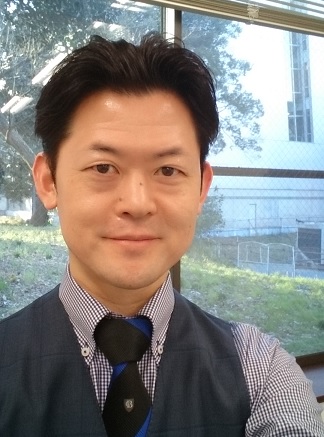 |
特任教授 | |
| 大田 佳宏 | ||
| Professor Yoshihiro OHTA | ||
| 所属: | 東京大学大学院数理科学研究科 | |
| 専門分野: | 数理生物学、超離散系シミュレーション | |
| 略歴: | 東京大学大学院理学系研究科情報科学専攻修士課程修了. IBM東京基礎研究所, 日立製作所中央研究所, 東京大先端科学技術研究センターなどを経て現職. 博士(数理科学)(東京大学). |
|
|---|---|---|
研究内容
細胞実験の自動化による超高密度な時空間ビッグデータの産出と、その数理解析によって遺伝子の転写メカニズムを解明し、革新的な転写創薬プロセスを実現するための研究を行っている。
また、実験自動化ロボットに搭載する AI (Artificial Intelligence) の研究開発も行っており、複雑かつ繊細な作業とビッグデータ解析まで行う自律発見ロボットの開発も行っている。
現在は、先端的な企業、病院、大学などと連携することで、画期的な創薬につながる融合研究を推進している。
数理科学分野においては、超離散系セルオートマトンを用いた遺伝子転写機構の時空間モデリングとシミュレーションの研究、および、Fatgraphなど代数的トポロジーを用いたタンパク質立体構造解析の研究を行っている。
RNA polymerase II (RNAPII) is the responsible motor protein for transcription. We report the formulation and results of a cellular automaton model of the RNAPII dynamics of gene transcription that takes account the effect of the velocity change according to the gene position. We found that the RNAPII molecules move as a free-flow state, though regions of reduced velocity do exist such as exons. If the reduction is strong enough to reach a certain threshold, a transition occurs from the RNAPII free-flow state to the states with congested and repetitive flows.
We also report the modeling and application that allows preferential paths of different dimensions only restricted to visit some transit points. According to its position, an RNAPII protein molecule prefers paths obeying two types of time-evolution rules. One is an asymmetric simple exclusion process (ASEP) along DNA, and the other is a three-dimensional jump between transit points in DNA where RNAPIIs are staying. Simulations based on our model, and comparison experimental results, reveal how RNAPII molecules are distributed at the DNA-loop-formation-related protein binding sites as well as CTCF insulator proteins (or exons). Apparent far-distance jumps in one dimension are realized by short-range three-dimensional jumps between DNA loops.
We confirm the above conjecture by applying our model calculation to the SAMD4A gene by comparing the experimental results. Our probabilistic model provides possible scenarios for assembling RNAPII molecules into transcription factories, where RNAPII and related proteins cooperatively transcribe DNA.
「遺伝子転写機構の時空間シミュレーションの研究」
遺伝子の転写とは、DNA配列を鋳型にRNA polymerase II (RNAPII)という酵素によって遺伝子が読まれRNAが合成される現象を指します。
このRNA配列からアミノ酸やタンパク質が作られるため、遺伝子の転写機構は「生命の基本原理」と考えられており、そのメカニズムの解明がとても重要視されています。
一方で、転写の生成物であるRNAは時間変異性が高く、微小不均一性を持つため、細胞を用いた実験において、高時間分解能の現象観察を行うことは難しいのが現状です。
そこで、観察不可能な領域における高分解能の検証を可能とし、さらに構築したモデルの再現性を保証するため、超離散系シミュレーションなどの数理科学的手法が必須となっています。
本研究では、転写過程における高時間分解能の細胞実験において、大規模配列解析実験から産出されるRNAPIIのダイナミクス、エピゲノム修飾、クロマチンループ構造などの時空間数値データの数理解析を行っています。
さらに、Cellular Automaton (CA) などの超離散モデリングを用いて転写数理モデルを構築してシミュレーションを行い、それらを細胞実験結果とあわせて検証する、というサイクルを有機的に推進することで、遺伝子の転写機構を明らかにしたいと考えています。
「代数的トポロジーを用いたタンパク質立体構造解析の研究」
代数的トポロジー分野においてR.C.Pennerらはグラフ理論の点と線に幅をもたせたFatgraph表現を用い、タンパク質の立体構造をトポロジー的手法を用いて定式化しました [Penner et al, Commun on Pure and Applied Math, LXIII,1249 (2010)]。
本研究では、このFatgraphを応用して、転写因子などのタンパク質の立体構造解析に適用するオリジナルプログラムを構築しています。
さらに本プログラムを用いて、アミノ酸配列に変異を入れた際の立体構造の変化、ドメイン構造変化、ペプチドユニットベクトルの SO(3)回転遷移特性などを比較解析し、抗原・抗体を評価する上での新しいタンパク質立体構造解析の利用技術を確立したいと考えています。
担当講義
- 数理科学基礎 [理科I類1年生(1−6組)の必修科目S1ターム、および文科各類の選択科目] を担当。
- 線型代数学 [理科I類1年生(1−6組)の必修科目S2,A1,A2ターム、および文科各類の選択科目] を担当。
- 数学II ㈰ ㈪(線型代数学)[理科I類1年生の通年・必修科目、および文科各類の選択科目]を担当しています。
- 現象数理II(理学部数学科3年生対象)の一部の講義を担当しています。
- 全学自由ゼミナール(教養学部前期課程の選択科目)の一部の講義を担当しています。
原著論文
- Maejima T, Inoue T, Kanki Y, Kohro T, Guoliang Li, Ohta Y, Kimura H, Kobayashi M, Taguchi A, Tsutsumi S, Iwanari H, Yamamoto S, Aruga H, Dong S, Stevens JF, Poh HM, Yamamoto K, Kawamura T, Mimura I, Suehiro J, Sugiyama A, Kaneki K, Shibata H, Yoshinaka Y, Doi T, Asanuma A, Tanabe S, Tanaka T, Minami T, Hamakubo T, Sakai J, Nozaki N, Aburatani H, Nangaku M, Ruan X, Tanabe H, Ruan Y, Ihara S, Endo A, Kodama T, Wada Y.
"Direct Evidence for Pitavastatin Induced Chromatin Structure Change in the KLF4 Gene in Endothelial Cells",
PLoS One. 2014 May 05;9(5):e96005. doi: 10.1371/journal.pone.0096005. - Ohta Y and Ihara S.
"Ultradiscrete Modeling and Simulation for Gene Transcription",
RIMS Kokyuroku Bessatsu, The breadth and depth of nonlinear discrete integrable systems, pp 101 - 124, 2013. - Ohta Y, Nishiyama A, Wada Y, Ruan Y, Kodama T, Tsuboi T, Tokihiro T, Ihara S.
"Path-preference cellular-automaton model for traffic flow through transit points and its application to the transcription process in human cells",
Physical Review E 86, 021918, (2012) [11 pages]. - Kawamura T, Ogawa Y, Nakamura Y, Nakamizo S, Ohta Y, Nakano H, Kabashima K, Katayama I, Koizumi S, Kodama T, Nakao A and Shimada S,
"Severe dermatitis with loss of epidermal Langerhans cells in human and mouse zinc deficiency",
The Journal of Clinical Investigation, 122(2): 722 - 732, 2012. - Ohta Y, Kodama T, Ihara S,
"Cellular-automaton model of the cooperative dynamics of RNA polymerase II during transcription in human cells",
Physical Review E 84, 041922 (2011) [15 pages]. - Kanki Y, Kohro T, Jiang S, Tsutsumi S, Mimura I, Suehiro J, Wada Y, Ohta Y, Ihara S, Iwanari H, Naito M, Hamakubo T, Aburatani H, Kodama T, Minami T.
"Epigenetically coordinated GATA2 binding is necessary for endothelium-specific endomucin expression",
The EMBO Journal, 30, 2582-2595, June 10, 2011. - Daigo K*, Kawamura T*, Ohta Y*, (* These 3 authors contributed equally), Ohashi R, Katayose S, Tanaka T, Aburatani H, Naito M, Kodama T, Ihara S, Hamakubo T.
"Proteomic analysis of native hepatocyte nuclear factor-4α (HNF4α) isoforms, phosphorylation status, and interactive cofactors",
The Journal of Biological Chemistry, Vol.286, No.1, pp.674-686, Jan.7, 2011. - Papantonis A, Larkin JD, Wada Y, Ohta Y, Ihara S, Kodama T, Cook PR,
"Active RNA Polymerases: Mobile or Immobile Molecular Machines?",
PLoS Biology, July 2010, Volume 8, Issue 7, e1000419. - Wada Y* & Ohta Y*, (* These 2 authors contributed equally to this work.), Xu M, Tsutsumi S, Minami T, Inoue K, Komura D, Kitakami J, Oshida N, Papantonis A, Izumi A, Kobayashi M, Meguro H, Kanki Y, Mimura I, Yamamoto K, Mataki C, Hamakubo T, Shirahige K, Aburatani H, Kimura H, Kodama T, Cook PR, Ihara S.
"A Wave of Nascent Transcription on Activated Human Genes",
Proceedings of the National Academy of Sciences, 2009 Oct 27; 106 (43): 18357 - 61.
[Science Editors' Choice, vol.326, 13 Nov., 2009.] - Kazama J, Makino, T, Ohta Y, Tsujii J,
"Tuning Support Vector Machines for Biomedical Named Entity Recognition",
40th Anniversary Meeting of Association for Computational Linguistics (ACL-02) 2002. - Ohta Y, Yamamoto Y, Okazaki T, Uchiyama I, Takagi T,
"Automatic Construction of Knowledge Base from Biological Papers",
Proceedings of the Fifth International Conference on Intelligent Systems for Molecular Biology (ISMB97), pp.218-225, Jun. 1997.
受賞
- The EMBO (European Molecular Biology Organization) Cover Contest 2011 入選
- Nature Asia-Pacific HIGHLIGHTS, 23 February 2010.
- Science Editors' Choice vol.326, 13 Nov. 2009.
解説・書籍
- 大田佳宏, 井原茂男, "遺伝子転写機構の時空間シミュレーション",
「生体の科学」(医学書院) Vol.65, No.5, p.460?461, 2014 Sep.-Oct. - 井原茂男, 大田佳宏, "真核生物の転写機構の数理解析",
「生体の科学」(医学書院) Vol.65, No.5, p.458?459, 2014 Sep.-Oct. - 大田佳宏,「大規模相互作用解析のための情報処理」, --文献情報によるタンパク質相互作用データの評価法",
実験医学別冊「決定版!プロテオーム解析マニュアル- 発現解析・機能解析の最新プロトコールからデータ整理,トラブル対処法まで」, 礒辺俊明,高橋信弘/編, 羊土社 4章-5, 2004/03. - 大田佳宏, 夏目 徹,「大規模相互作用解析のためのインフォマティクス",
実験医学別冊「注目のプロテオミクスの全貌を知る!」羊土社 3章-1, 2002/12.
招待講演
- 大田佳宏, 「Cellular-automaton model of the cooperative dynamics of RNA polymerase II during the transcription process in human cells」,
文部科学省科学技術試験研究委託事業「数学・数理科学と諸科学・産業との協働によるイノベーション創出のための研究促進プログラム」生命ダイナミクスの数理とその応用,
2015年12月11日, 東京大学大学院数理科学研究科 大講堂. - 大田佳宏, 「Ultradiscrete Modeling of Pol II dynamics for gene transcription」,
BMB2015 第38回日本分子生物学会年会、第88回日本生化学会大会 合同大会,
2015年12月3日, 神戸商工会議所3階 神商ホールB(第27会場). - 大田佳宏,「転写機構解明のための時空間数理モデル」,
生命動態システム科学四拠点・CREST・PRESTO合同シンポジウム「生命動態の分子メカニズムと数理」,
2015年3月16-17日 京都大学 芝蘭会館 稲盛ホール. - 大田佳宏,「遺伝子の転写機構解明のための数理モデル」,
Seminar on Mathematics for various disciplines (諸分野のための数学研究会),
2015年1月27日, 東京大学. - 大田佳宏,「転写機構解明のための数理モデルとシミュレーション」,
日本数学会(2014年度年会)「数学連携ワークショップ -生命科学、材料科学における数理-」(主催:文部科学省、統計数理研究所)2014年3月16日, 学習院大学. - 大田佳宏,「転写過程の情報処理と数理モデル」,
数学協働プログラム「生命ダイナミックスの数理とその応用」(主催:統計数理研究所), 2014年1月22日, 東京大学大学院数理科学研究科 大講義室. - 大田佳宏,「転写のCA モデルとシミュレーション」,
研究集会 [島根大学[数理生物]-東京大学iBMath 合同研究会:生命動態の実験,数理モデルおよびシミュレーションの現状と今後の課題], 2013年12月27日, 島根県 一畑東館. - 大田佳宏,「転写過程の超離散モデリングとシミュレーション」,
京都大学数理解析研究所研究集会 [非線形離散可積分系の拡がり], 益川ホール, Aug. 21, 2012. - Yoshihiro Ohta,「Literature/Text Data Mining」,
BioIT World Japan, 9/18, 2003. - Yoshihiro Ohta,「Extracting Protein Interactions from Papers」,
The 51th Annual Conference of the Mass Spectrometry Society of Japan, May, 2003.
国内・国際特許
国内特許 11件, 国際特許 6件.
国際会議の発表(査読有)
- Ohta Y, Wada Y, Kodama T, and Ihara S,
"High Density Spatial and Temporal Simulation Reveals Transcriptional Dynamics",
The Pacific Symposium on Biocomputing (PSB), Kona, USA, 2011. - Ohta Y, Natsume T, Ohi H, Nishikawa T, and Hisamitsu T,
"Extracting Knowledge from Biomedical Literature for Valiant Sequence Analyses",
The Pacific Symposium on Biocomputing (PSB), Mauna Lani, USA, 2004. - Ohta Y, Natume T, Nishikawa T, Ohi H, and Hisamitsu T,
"ExMI: Extracting Molecular Interaction from Large Biomedical Literature", The 11th International Conference on Intelligent Systems for Molecular Biology, Brisbane, Australia, 2003. - Ohta Y and Ihara S,
"Extraction and Dynamic View of Biomolecular Interactions in Large Biomedical Text Database",
The 10th International Conference on Intelligent Systems for Molecular Biology, Edmonton, Canada, 2002. - Ohta Y, Nishikawa T, and Ihara S,
"Production System for Mining in Large Biological Data Set",
The 9th International Conference on Intelligent Systems for Molecular Biology,
Copenhagen, Denmark, 2001. - Ohta Y, Nishikawa T, and Ihara S,
"Information Extraction System for Protein-Protein Interactions",
The Pacific Symposium on Biocomputing (PSB), Mauna Lani, USA, 2001. - Ohta Y, Nishikawa T, and Ihara S,
"IFBP: Information Finding from Biological Papers",
The Pacific Symposium on Biocomputing (PSB), Mauna Lani, USA, 1999. - Ohta Y. and Shibuya T,
"Extracting Causalities from Large Biological Data Set",
Annual Meeting on Molecular Biology 1998. - Ohta Y, Yamamoto Y, Uchiyama I, Takagi T,
"Information Finding from Biological Papers",
Proc. of the Seventh Workshop on Genome Informatics, Dec. 1996.

